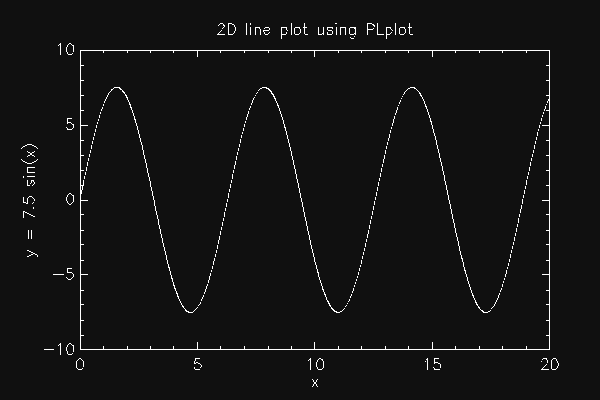PLplot
PLplot is a multi-platform scientific plotting library written in C, with bindings available for a broad range of programming languages, such as C++, Java, Lua, Octave, Python, but Fortran as well. PLplot features non-interactive and interactive device drivers, i. e., the output is either written to file in PNG, SVG, PDF, and other formats, or shown in a window (X11, Qt, GTK). The library is licenced under LGPL.
The core library provides routines to create XY plots, semi-log plots, log-log plots, contour plots, 3D surface plots, mesh plots, bar charts, and pie charts. It is possible to place multiple graphs on a single page, and multiple pages are allowed for those devices that support them.

- Fig. 1: Example output of PLplot
Installation
PLplot is available as a package on most Unix-like operating systems. Just
install package math/plplot on FreeBSD:
# pkg install math/plplotMake sure that the package has been built with Fortran support. Any Fortran
application has to be linked either against -lpgplot (shared
library) or libpgplot.a (static library) to access the PLplot
procedures, additionally to -lX11. The PLplot package includes a
selection of example programs in directory
/usr/local/share/plplot5.15.0/examples/fortran/ (FreeBSD).
Example
The following very basic example simply plots a sine wave using PLplot (fig. 1).
! plot.f90
program plot
use :: plplot
implicit none
integer, parameter :: N = 2000
real, parameter :: XSTEP = 0.01
real :: x(N), y(N)
real :: xmax, xmin, ymax, ymin
integer :: i, rc
xmin = 0.0
xmax = XSTEP * N
ymin = -10.0
ymax = 10.0
! Prepare data.
do i = 1, N
x(i) = XSTEP * i
y(i) = 7.5 * sin(x(i))
end do
! Parse and process command line arguments.
rc = plparseopts(PL_PARSE_FULL)
if (rc /= 0) stop 'Error: Parsing command-line arguments failed'
call plscolbg(16, 16, 16) ! Set background colour (RGB).
call plinit() ! Initialise PLplot.
call plcol0(15) ! Set foreground colour.
! Create a labeled box that contains the plot.
call plenv(xmin, xmax, ymin, ymax, 0, 0)
call pllab('x', 'y = 7.5 sin(x)', '2D line plot using PLplot' )
! Plot the data as line diagram.
call plline(x, y)
! Close PLplot library
call plend()
end program plotCompile and link the example against -lplplotfortran:
$ gfortran14 -I/usr/local/lib/fortran/modules/plplot -o plot plot.f90 -lplplotfortranExecute the binary with desired output device and plot size:
$ ./plot -dev xwin -geometry 640x400Passing the command-line argument -h prints all available
options to stdout:
$ ./plot -h
Usage:
./plot [options]
PLplot options:
-h Print out this message
-v Print out the PLplot library version number
-verbose Be more verbose than usual
-debug Print debugging info (implies -verbose)
-dev name Output device name
-o name Output filename
-display name X server to contact
-px number Plots per page in x
-py number Plots per page in y
-geometry geom Window size/position specified as in X, e.g., 400x300, 400x300-100+200, +100-200, etc.
-wplt xl,yl,xr,yr Relative coordinates [0-1] of window into plot
-mar margin Margin space in relative coordinates (0 to 0.5, def 0)
-a aspect Page aspect ratio (def: same as output device)
-jx justx Page justification in x (-0.5 to 0.5, def 0)
-jy justy Page justification in y (-0.5 to 0.5, def 0)
-ori orient Plot orientation (0,1,2,3=landscape,portrait,seascape,upside-down)
[...]Output Devices
The supported output device drivers are selected through command-line
argument -dev (tab. 1).
-
Parameter Description xwinX window (Xlib) psPostScript file (monochrome) pscPostScript file (color) xfigFig file nullNull device memUser-supplied memory device psttfPostScript file (monochrome) psttfcPostScript file (color) svgScalable Vector Graphics (SVG 1.1) xcairoCairo X window driver pdfcairoCairo PDF driver pscairoCairo PostScript driver epscairoCairo EPS driver svgcairoCairo SVG driver pngcairoCairo PNG driver memcairoCairo memory driver extcairoCairo external Context driver - Tab. 1: Selection of output devices supported by PLplot
References
- PLplot: Official website
- Documentation of the PLplot plotting software (PDF)
Further Reading
- V. Sharma: Using PLplot with Fortran
| < PGPLOT | [Index] | DISLIN > |